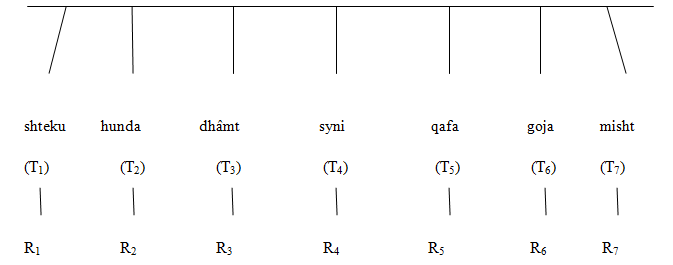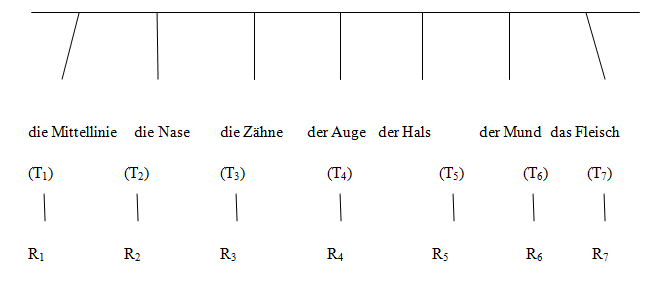АНАЛИЗ НОМИНАЛЬНЫХ ЗНАКОВ В ТЕКСТЕ ПЕСНИ «MARTESA E HALILIT» И В НЕМЕЦКОЙ ВЕРСИИ В ПЕРЕВОДЕ М. ЛАМБЕРЦА
Аннотация
As a linguistic sign, noun is among the most important classes of the linguistic signs and the information carrier in the text at the same time. Two meaningful noun subclasses are proper nouns (Eigennamen), identifying a person or a thing name and the common nouns (Gattungsnamen), whose meaning includes a broader extend (Umfang) and content (Inhalt). By form, names are linked with the grammar category of gender (Genus des Nomens), number (Numerus des Nomens) and case (Kasus des Nomens). German and Albanian languages have three noun genders: male gender (Maskulin), female (Feminin) and neutral (Neutrum). Despite the noun gender category, the number concept (Numerus) of noun aggregates a binary opposition: Singular and Plural. Finally, case is expressed by inflection of articles either as constituent or effective component (,,efektiv”) of case inflection. On the other hand, noun is a fragmentary constituent (,,defektiv”) of case inflection [1, 230-231; 236-251]. Another very important issue linked with the noun is its determination by other different determiners of the nominal group such are: other nouns, pronouns, articles [2, 146-344], and the noun have a referential dependency to these linguistic signs (Referenzzusammenhang). [3, 317-375]
Noun is defined by various determiners who in the text are seen as attributes. Such attributes could be as pre-determining (prädeterminierende Atributte) and post-determining (postdeterminierende Atributte). Noun and its attributes, be they pre or post ones in text, forms the nominal group (Nominalgruppe). As predetermining attributes, could be used prepositional adjuncts (Präpositional -Adjunkte), gender adjuncts (Genitiv-Adjunkte) and relative adjuncts (Relativ-Adjunkte). Whilst, as post ones the followings: adjuncts of (Genitiv-Adjunkte), prepositional adjuncts (Präpositional – Adjunkte), conjunction adjuncts (Konjunktional – Adjunkte), infinitive adjuncts (Infinitiv-Adjunkte), relative adjuncts (Relativ-Adjunkte) and attributive adverbs (attributive Adverben). The post-attribute is regarded as apposition (Apposition). [3, 317-367]
Whilst communicating, the role of the giver and the receiver is determined as negative due to the fact that the situation refers nothing to these two contextual elements [5, 19]. The referential role is critical so as to explain this phenomenon, a role that in the text provides reference to various references. As the reference of semantic precision is seen the referential role in all nouns and pronouns throughout the text. Textual references are noticed at the textual recurrences (textuelle Rekurrenz). The simplest recurrence form is repetition of same nouns. Meanwhile, the most complex ways of recurrences are the constituents of the textual themes (konstituive für die textuelle Thematik) and quasi-recurrence (Quasi-Rekurrenz). As constituents of textual thematic are the repetition of nouns in text through other nouns with analogous meanings. Quasi-recurrence on the other hand, could be seen by the use of a range of various nouns with same or similar meanings. Such tools of text building are regarded as stylistic means. [3, 368-371]
In the text of ,,Martesa e Halilit” [5, 27], a song translated in german by Lamberc, together with other textual signs, nominal textual signs are very important too. The said text, in Albanian language is in verses while in German language in prose. In this text, jointly with other textual signs, cohesion constituents are nouns, noun determiners, noun references, textual thematic constituent elements (complex forms of noun repetition in the text) and quasi-recurrences. Nouns in this text as well as in other texts in Albanian, comparing to their determiners, are predominantly placed in front [6, 219-223]. Occasionally, nouns are even placed at the very beginning of the verse. Their starting position in the sentence respectively in the verse, in this very text is determined by the nature of text as the poetical creativity. Placing the noun before its determiners, i.e. adjective and noun in genitive case, appears in the following verses:
,, Se gjith grát e krahinës, ku janë,
,, Se gjith vashat e Jutbinës, ku janë,
,, Bash si motra qi po m’duken.”
,, Alle Frauen unseres Landes, alle Mädchen von Jutbina sind mir wie Schwestern”
,,Po s’e mora Tanushën e krajlit”
,, Sterben will ich, wenn ich nicht Tanusha, die Tochter des Königs, zur Frau gewinne”
,Shteku i ballit, si shteku i malit,
,, …, die Mittellinie ihrer Stirn ist wie der Pfad über einen Berg …”
,,Hunda ndrejt, si kalêmi i Tushës !”
…, ihre Nase gerade wie der Gewehrlauf aus der Werkstatt des Waffenschmiedes Tusha,…”
,,E ka qërpikun, si krahi i dallendyshës ;” …, ihre Augenlider wie Schwalbenflügel, …”
,, Dhâmët e bardhë, si gurzit e lumit,” , ihre Zähne weiß, wie die Kieselsteine des Flusses nach dem Regen,…”
,, Syni i saj, si kokrra e qershís ;” …, ihr Auge wie die Kirsche ,…”
,,Qafa e saj, si qafa e pllumbit:” ,, …, ihr Hals wie der Hals der Taube ,…”
,, Goja e vogël, si lulja qi shpërthen ;” ,,…, ihr Mund klein wie die Blüte ,…”
,,Misht e dorës, porsi rrêmi i shemshirit” ,,… das Fleisch ihrer Hand wie die Blüte der Myrte!”
In the analyzed samples could be seen that the noun determiners in Albanian text are accompanied with noun in genitive, adjective but there are cases too when noun is not followed by its determiners at all.
,, Syni i saj, si kokrra e qershís ;” …, ihr Auge wie die Kirsche ,…”
In few cases in this text, Lamberc uses composite to translate noun in genitive:
,,E ka qërpikun, si krahi i dallendyshës ;” …, ihre Augenlider wie Schwalbenflügel, …”
Noun signs as textual-building signs in ,,Martesa e Halilit” song are accompanied with referential signs as well, through which is arranged and developed the semantic meaningful body of the text. Noun referential signs in the said text appears in the following verses:
,,Vetulla e saj ndrejt si fiskaja;” Ihre Augenbrauen sind wie ein junger Eichenwald,..”
,, Syni i saj, si kokrra e qershís ;” …, ihr Auge wie die Kirsche ,…”
,,Qafa e saj, si qafa e pllumbit:” ,, …, ihr Hals wie der Hals der Taube ,…”
,,Shtati i saj, si ‘ i shtat çetinet;” ,, …, ihr Körper wie der Fichtenstamm ,…”
Noun referential signs both in Albanian and in the translated text do appear with possessive pronouns, who settle in with nominal signs in gender and number [6, 284-291]. It could be said, that the position of pronoun referential signs in the analyzed text in Albanian do vary from the position of the referential signs in the translated text. Such signs in the Albanian text are placed after the noun all the time while in the german text always in front of the noun.
Quasi-recurrences of the nominal signs are of huge relevance in the text, especially in the structure of the texts having literary and poetical values for the reason that provide artistic effects of a comparative and metaphoric nature and are a constituent element of the song style. In this text, quasi-recurrences of the nominal signs are expressed in the next verses:
,,Vetulla e saj ndrejt si fiskaja;” -Ihre Augenbrauen sind wie ein junger Eichenwald,..”
,, Syni i saj, si kokrra e qershís ;” …, ihr Auge wie die Kirsche ,…”
,, Ftyra e saj, si kuqet molla n’degë ;” ,, …, ihr Gesicht wie der Apfel ,…”
,,Hunda ndrejt, si kalêmi i Tushës !”
…, ihre Nase gerade wie der Gewehrlauf aus der Werkstatt des Waffenschmiedes Tusha,…”
,, Goja e vogël, si lulja qi shpërthen ;” ,,…, ihr Mund klein wie die Blüte ,…”
Seeing the review done so far, we could add that the cohesion of ,,Martesa e Halilit” text is developed so as to support the multiplicity of the textual cohesive signs establishing a bond link between words, sentences and the whole text body [7, 7-14]. In this way, the entire connection of the textual signs constructs the coherence of this song. Relying on building up the cohesion of this poetically narrative text it could be seen that the nouns, determiners and noun referential signs do follow it from the beginning till the end:
- As noun determiners in the said text comes out the following –province women (Frauen unseres Landes), girls of Jutbina (Mädchen von Jutbina), Tanushën e Krajlit (Tochter des Königs), swallow arm (Schwalbenflügel), cherry grain (die Kirsche), dove neck (Hals der Taube), small mouth (ihr Mund klein), white teeth (ihre Zähne weiss), river shingles (die Kieselsteine des Flusses),
- As noun referential signs in the text comes out the next examples – her eyebrow ( ihre Augenbrauen), her eye ( ihr Auge), her neck (ihr Hals), her body (ihr Körper),
- As quasi-recurrences the following : ,,Hunda ndrejt, si kalêmi i Tushës !”
…, ihre Nase gerade wie der Gewehrlauf aus der Werkstatt des Waffenschmiedes Tusha,…”
,, Dhâmët e bardhë, si gurzit e lumit,”
, , ihre Zähne weiß, wie die Kieselsteine des Flusses nach dem Regen,…”
,,E ka qërpikun, si krahi i dallendyshës ;”
…,, ihre Augenlider wie Schwalbenflügel, …”
Whereas, based on the informative constituents of the text that is to say on topic and comment, could be mentioned that the topic and comment as textual coherence primary constituents are seen in the text of ,,Martesa e Halilit” song as well. The whole text is a progressive type with deriving subject (Die Progression mit abgeleiteten Themen), resulting in a hyper theme out of specific sentences: [8, 45]
Shteku i ballit, si shteku i malit,
,,Die Mittellinie ihrer Stirn ist wie der Pfad über einen Berg …”
,,Hunda ndrejt, si kalêmi i Tushës !”
,,Ihre Nase gerade wie der Gewehrlauf aus der Werkstatt des Waffenschmiedes Tusha,…”
,, Dhâmët e bardhë, si gurzit e lumit,”
,,Ihre Zähne weiß, wie die Kieselsteine des Flusses nach dem Regen,…”
,, Syni i saj, si kokrra e qershís ;” ,,Ihr Auge wie die Kirsche ,…”
,,Qafa e saj, si qafa e pllumbit:” ,,Ihr Hals wie der Hals der Taube ,…”
,, Goja e vogël, si lulja qi shpërthen ;” ,,Ihr Mund klein wie die Blüte ,…”
,,Misht e dorës, porsi rrêmi i shemshirit”
,,Das Fleisch ihrer Hand wie die Blüte der Myrte!”
All these sentences develop the text coherence by being a deriving progression of some themes producing a hyper theme. Hyper theme becomes known from the given themes[8, 44-65], and ins our case it is the case of ,,bukuria e Tanushës – die Schönheit von Tanusha”. The entire such progression of deriving themes can be introduced via schematic way and it includes the unknown theme information, that is to say comment (Rhemen) for each sentence separately:
Fig. 1 - Hipertema (bukuria e Tanushës)
Fig. 2 -Hyperthema (die Schönheit von Tanusha)
Список литературы
Helbig G. Deutsche Grammatik. Verlag Enzyklopädie / G. Helbig, J. Buscha; durchgesehene Auflage. – Leipzig, 1993. – S. 230-231; 236-251.
Die Grammatik. // DUDEN, Band 4. – Mannheim, 2006. – S. 146-344.
Weinrich H. Textgrammatik der deutschen Sprache / H. Weinrich. – Georg Olms Verlag, AG, 4. Auflage, Hildesheim, 2007. – 1111 s.
Rein K. Einführung in die Kontrastive Linguistik / K. Rein. – Wissenschaftliche Buchgesellschuftz, Darmstadt, 1983. – S. 19.
Palaj B. Visaret e kombit II- Kangë kreshnikësh dhe legjenda / B. Palaj, D. Kurti. – Tiranë, 1937. – S. 27.
Bucholz O. Albanische Grammatik / O. Bucholz, W. Fiedler. – VEB Verlag Enzyklopädie, Leipzig, 1987. – S. 219-223.
Klisch-Averintseva M. Textkohärenz / M. Klisch-Averintseva. – Universitätsverlag Winter GmbH, Heidelberg 2013, – S. 7-14.
Brinker K. Linguistische Textanalyse. Eine Einführung in Grundbegriffe und Methoden / K. Brinker. – Erich Schmidt Verlag, Berlin, 2010, – S. 45.


